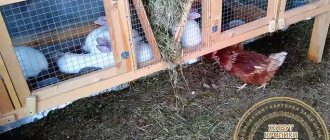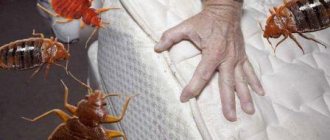As practice shows, a mole net is in most cases the optimal means of protecting an area from these animals, and in terms of effectiveness, safety and ease of use it is superior to almost all other methods of controlling moles. And the main advantage of anti-mole nets is that when used correctly, their reliability as a mechanical barrier agent is very high.
However, even when using lawn nets, it is not always possible to obtain the desired result. But, it would seem, everything is simple: we lay the mesh to a depth of about 5-10 cm, or dig it along the perimeter of the site to a depth of 80 cm - and voila, you can forget about moles.
But in reality, not everything is so simple, and it may be necessary to take into account a number of important nuances that are not written about in the instructions, but without taking them into account, the entire result of using the mesh can be nullified. And we will also talk about this below...
Review
“For three years, moles literally cut down all our attempts to make a normal lawn and flower garden. It seems like there aren’t any of them and there’s nowhere to look, but then bam - and a bunch of them grow in the middle of the sown area. For my wife, the alpine slide was torn apart, like a volcano exploded. So what should I do? Last winter I couldn’t stand it, I closed three sides of the plot that overlook the neighbors and the road with a fence, and the foundation was made with moles in mind. According to the standards, 40 cm is enough, I did 60, because they are unlikely to get through that way. I spent a lot of money, but I did my best for the site. The fourth side was covered with a net. He called a trencher and made a trench 20 cm wide and 80 cm deep, laid a mesh with a 25x25 mesh, and released the rest to the top (another half a meter turned out). Every two meters I placed pipes 2 m high, they stuck out 1.20 above the ground. The base of the pipes was concreted. I filled everything up, put another mesh between the pipes - this is a normal fence. I tore up the top layer of 20 cm from the lawn, put in a special anti-mole net, bought Merlin from Leroy. I put the lawn back in place. All. It's August and there's no one else to be seen. It was expensive, but it’s worth it, my wife was able to make an alpine slide again.”
Maxim, Moscow
Mole protection net, how does it work?
The mole net is a continuous fabric made of durable materials. The cellular structure does not restrict air access to plants, but stops the movement of pests. The smaller the cells, the more effective the protection. In addition to moles, the net helps protect plantings from other rodents.
The operating principle is simple:
- The canvas is buried 10-15 cm into the ground so that it blocks the rodent from coming to the surface.
- When faced with a barrier, the mole is forced to dig a new hole. When constructing protection throughout the entire area, shrews will not break through to throw out soil, and therefore will abandon their inhospitable owners.
In theory, there is no problem with using a mesh under the lawn, but in practice the situation is a little more complicated.
Nuances of choice
There are several ways to lay out protection - vertical, horizontal, universal. The work ahead will be extensive and difficult - you will have to lift the soil, dig trenches or hire equipment. Savings in this case will come at the cost of ineffective measures, so it is worth including all the costs for protection and subsequent development of the site.
Which mole net to choose:
- Metal cloth. The material, which is not resistant to rust, will require replacement after a few years. You will have to re-raise the soil and re-layer the protection, otherwise moles, mice and rats will gain full access to the surface of the soil.
- Plastic construction. A more durable material that can withstand aggressive conditions, water, and frost. Plastic does not rot or rust, and by choosing polypropylene products, the owner has the hope that rats will not be able to cope with the protective fabric.
As for cell sizes, the smaller the better. The optimal option is a clearance of up to 25 mm. Even mice, the faithful “companions” of moles in the country, will not penetrate such a hole.
Features of installing protective fabric
There are several options for laying out anti-mole mesh under the lawn:
- Laying around the perimeter of the entire garden. This will protect the area from pests from the outside. Used for dachas with an area of up to 30 acres. If the site is fenced with a fence on a strip foundation, the mole net is dug in from the unprotected side. A depth of up to 0.8 m will allow all entrances/exits to be blocked.
If there are moles in the ground during the period of work, they are caught. Otherwise there will be no result.
- Horizontal layout. The soil is raised by 100-150 mm, then a protective sheet is laid out and covered with earth again. Be sure to carefully connect the sheets to prevent the mole from moving the mesh and throwing the soil out. The method is suitable only if the lawn is arranged. If the mesh under the lawn is laid on an area for planting bushes or beds, choose a different method.
The disadvantage of horizontal laying out is that rodents can easily dig feeding passages above the canvas. For example, there were mole rats up to 50 mm in size on the site, and the canvas was buried 150 mm. Pests will feel at ease in the soil; protection will not hinder them at all.
- Vertical or island display. Used in limited areas where it is necessary to protect the bed from rodent invasion. The structure is deepened by 150-200 mm, and up to 300 mm of mesh is also brought up. Convenient for high beds, but inconvenient for flower beds.
Before buying mole nets, it is worth considering all the advantages and disadvantages of using canvas.
Options for laying mesh over an area and digging it in around the perimeter
The anti-mole net performs exclusively a barrier protective function on the site. It does not scare away moles, does not kill them, but simply prevents the animals from moving into the fenced area:
- making its way and approaching the border of the site from the outside, the mole stumbles upon the net, unsuccessfully tries to get around it and ultimately remains outside the site;
- if the mole is already on the site and tries to dig a passage to the surface of the earth, then it, again, stumbles upon the net and is forced to go deeper underground again.
To protect a cottage or garden from the penetration of moles from the outside, the net is buried vertically in the ground along the perimeter of the entire area. This option is optimal for relatively small private properties with an area of up to 20-30 acres. If they already have fences (with a deep solid foundation) on one or more sides, or a road adjoins some sides, then this makes the task even easier - only those sides will have to be covered with mesh where there is still a risk of moles entering from neighboring territories.
On a note
In practice, it sometimes happens that moles do not penetrate into areas where the owners have the opportunity to build full-fledged fences with a solid strip foundation, even if the foundations of these fences are not very deep. In such cases, first of all, unprotected neighboring areas suffer from moles, the owners of which neglect at least some kind of fences and hope to scare off the moles, for example, with rotten fish or cat urine. In the end, everyone gets what they expect: some get a clean, well-groomed plot of land with a fence, others get a vegetable garden strewn with rotten fish and covered in cat urine (often also studded with beer cans on the fittings).
It is important to keep in mind that if there are already moles on the site and it is decided to limit yourself to installing a net around the perimeter (that is, not laying it additionally over the entire area), then at about the same time when the net is installed, the animals themselves need to be caught and taken out. boundaries of the site. Otherwise, they will continue their destructive activities in the fenced area.
Important
The mesh must be installed on all sides of the site, along which there are no roads, fence foundations or other barriers for moles. Many summer residents reason like this: moles most likely come from the side of the forest or field, which means that it is enough to cover this side with a net to protect the area.
This approach has two weaknesses: “most likely” does not always correspond to reality, and even if it does, very active, active and mobile moles often manage to bypass the grid (sometimes even on the surface of the earth during the settlement period). Therefore, a mesh on only one side of the site will not save you if the others are not covered by anything.
Another option is to lay the lawn mesh horizontally over the protected area to a depth of about 5-10 cm underground. In this case, the mole, making a move, rises up to throw out the earth, stumbles upon the mesh, tries to tear it or go around it, cannot do this, and eventually goes either deeper underground again, or to the side, reaching the edge where the mesh no, that is, outside the territory protected by the mesh.
Cucumber cultivation and care, what is useful, how to eat it, reviews, photos
This method is especially often and quite successfully used to protect lawns where deep planting is not planned. It is the horizontally laid mesh that protects golf courses and decorative lawns in parks from moles.
The photo below shows an example of laying a lawn mesh:
The disadvantage of this method is that the mole can make feeding passages even above the mesh if it is laid too deep (judging by the reviews of summer residents, sometimes 10-15 cm of soil is enough for a mole). In addition, a mole can simply tear a not very high-quality mesh, and can also crawl through the joints of the mesh. In addition, mice and other rodents in the area often gnaw holes in the mesh, thereby making it easier for moles to reach the surface.
It should be taken into account that this option is not always suitable for vegetable gardens and flower beds, where the mesh will interfere with agricultural work.
On the other hand, this method of protecting a site from moles has, in general, many advantages: a mesh laid horizontally strengthens the soil, preventing displacement of its upper layers (which is especially important if the lawn is on a slope), helps level the terrain and prevents the formation of bald spots on the lawn.
Review
“We have no problems with moles at all. Although we have a sea of them in our fields, in the field around the village there are thousands of these molehills, even more than there is flat land. My plot is located 300 meters from the field, but there has never been a single mole on it. Even when it was being built, I installed stone fences with a foundation of 90 cm on the side of the road and the neighbor, this is enough. I also made a trench on the other two sides and stretched a fine mesh 90 cm down and 110 cm above the ground. I bought everything from Ob. Here they say that you need to bury 40 cm, but in reality this is not enough, I have 90 on all sides, there are hordes of moles around, and I’ve been living on the site for 12 years and haven’t seen a single one. So you need to think about it right away, even before the problem appears.”
Yaroslav, Odessa
Some summer residents try to fence off individual small areas on the site with netting, where the harmful work of moles is most undesirable. In principle, this method can be justified from the point of view of saving money, but additional problems arise with the formation of the above-ground part of the fence: in order for the mesh to protect against moles, it must be placed at least 20-30 cm above ground level, so that the animal cannot simply cross it on the surface. As a result, metal bars and mini-fences appear on the site, which do not always improve the landscape design of the area.
Sometimes people even try to plant bushes and young trees in baskets or holes fenced with mesh, so that moles don’t gnaw on the roots. Here it is necessary to clarify that moles do not gnaw the roots of trees and bushes. They are damaged by rodents - voles (especially water voles), rats and various insects, all of which move quite comfortably on the surface of the earth, and insects - through any mesh of the baskets, so such pseudo-barriers are not a hindrance for true pests of roots.
So, if you need to protect your summer cottage from moles as effectively as possible, then the mesh needs to be buried vertically around the entire perimeter, and in addition to this (if funds allow) it should be laid horizontally over the largest possible area.
Now let's talk about how to choose the right anti-mole net, since not all of them are equally effective, reliable and durable...
Traps
If the area is occupied by surprisingly brave animals that are not afraid of smells or noise, you will have to catch them. You don’t need to buy any special devices for this—a few three-liter jars are enough. They are buried in the ground along the path of molehills, symbolically covering them with a plank. The animal crawls onto it and falls inside.
Having discovered a prisoner, it would be wise not to kill him, but to take him outside the site and release him to freedom. As mentioned above, in nature, moles and shrews are very useful.
Operating principle
The anti-mole net is installed in a horizontal or vertical position. In the first case, it serves as a barrier to prevent moles from entering the area. It digs to a certain depth and does not allow the mole to make a passage. Since underground diggers dig tunnels at a level of 10-100 cm from the surface, it is advisable to bury the protective mesh at 150-200 cm.
The second installation option involves placing a grid over the entire plot of land at a certain depth. When digging tunnels and burrows, moles throw soil to the surface and form molehills. Not having received such an opportunity, the animal moves to the territory where this can be done.
On a note!
The principle of operation is extremely simple, but there are some nuances. Mole netting under the lawn does not always give the desired results. Despite the ease of use, there are certain rules that must be followed.
Installation methods
The main objective of the design is to prevent animals from entering the site or to stop their activities. The most correct option is to take care of protecting your property even before planting trees, garden crops, digging up flower beds and lawns. But as practice shows, the alarm begins to sound when large molehills appear on a beautiful lawn or young trees in the garden begin to suffer.
Nets for fighting moles in the garden
There are several ways to install mole netting.
- Vertical. It is laid on the surface of the earth in a continuous blanket over the entire lawn at a depth of 5-50 cm. The earth is poured on top or left to lie there. As the grass grows, the mesh will disappear and will not be visible.
- Horizontal. Designed for fencing the entire lawn. The structure is dug to a depth of 1 m around the perimeter of the entire garden, vegetable garden, lawn or in individual areas. The structure is removed from the ground by 20 cm, and a kind of fence is obtained.
- Solid. The mesh is laid as a continuous sheet over the entire area of the lawn. At the joints, one part of the mesh is placed on the second, overlapping by 10 cm.
Each case has its own disadvantages. When the mesh is placed vertically on the lawn, it is difficult to determine the optimal depth. The mole can hunt at a depth of 5 to 150 cm from the surface. To eliminate this drawback, additional horizontal protection of the lawn is required, which will not allow animals to climb onto the site.
Choosing the right material
Nets for protection against moles
The net has different cell diameters and is made of metal or modern polymer. To ensure a complete barrier, you need to take into account the size of the mole and the principle of its activity. The animal is small, averaging 13 cm in length. The body is flexible, oblong. The animal digs the ground with its front shovel-shaped paws with long claws, screws its muzzle and entire body into the hole. It throws away the soil with its hind paws. The cell size should be as small as possible, otherwise the mole will overcome the obstacle. Acceptable value is 25*25 mm.
The second very important point is the material. Iron mesh is strong, reliable, but short-lived. The material is in the ground, subject to deformation, corrosion, gradually rusting, and losing strength. In a few years, the mole will be able to break through, gnaw through the cells, and get into the garden bed, lawn, or garden. This drawback has been eliminated by manufacturers of modern anti-mole netting made from polymer materials.
On a note!
The plastic construction is extremely strong, durable, not exposed to the negative effects of moisture, resistant to frost and microorganisms. By installing a barrier on the lawn according to all the rules, you can forever forget about fighting moles on your site.
Is it possible to do without installing an anti-mole net?
What to do if moles are pestering you, but you are not ready to spend several tens of thousands of rubles to install a mesh?
The most effective method of controlling moles on a site today is:
Traps - mole traps
Even the simplest wire traps serve their purpose very effectively. Today, the best traps (based on customer reviews) are mole traps from the manufacturer SuperCat and devices from the Swiss company SWISSINO.
The photo shows the Mole Trap mole trap from Swissino (more details here)
However, the method with traps (traps) is not the most humane and requires constant monitoring of the traps to ensure that animal corpses are removed. If this method is unacceptable for you, you should pay attention to
Choose modern methods of protecting your garden area from moles
A special anti-mole net laid throughout the site will not allow the animal to get out. Having encountered such an obstacle several times, the mole will leave the area and go looking for a more favorable place to live.
setkaplast.ru is ready to offer mole netting for purchase, which will help owners of country houses and dachas avoid all the troubles associated with the appearance of this animal in the local area. The mesh should be laid in a continuous layer over the entire territory of the site and covered with a 5-8 cm layer of soil on top. This simple solution is reliable protection against moles. After laying the mesh, you will be able to carry out landscaping without worrying that the animal may spoil the external presentability of the local area over time. The mesh we recommend for mole control has the following advantages:
- made of high quality polymer materials,
- environmental friendliness and safety for the environment,
- resistance to all external factors,
- absence of rotting and corrosion processes,
- simplicity and speed of installation,
- long service life - 15-30 years.
Propagation of roses by cuttings at home: instructions + video
The polymer mesh does not scare off moles, but simply does not allow them to come to the surface, which creates noticeable discomfort for the animals. Preventing the appearance of a mole on your property is a mandatory measure if you want to enjoy the aesthetics of your local area in the future, and not discover new holes every day.
Why is a mole dangerous on the site?
The mole is a small mammal that lives primarily underground. It is insectivorous. Weighs from 10 to 70 g, its body length is from 5 to 20 cm. The body is covered with dark or black velvety fur. The mole's pile grows straight to the top, which allows it to move underground without problems, both forward and backward. The front paws with large claws look like shovels; the animal uses them to dig holes in the ground, screwing its muzzle and body into the hole; the hind paws are much weaker.
On a note! Poor vision or its complete absence is compensated by an excellent sense of smell and touch.
Shallow underground, the animals break through a network of feeding passages into which earthworms crawl. They are the main food of this animal; in addition to them, slugs, wood lice, chafer larvae, mole crickets, as well as frogs and even snakes are also eaten. Moles are incredibly voracious. They are cannibals; if you leave two hungry moles together for a long time without food, then soon a fight will begin between them and the stronger one will dine on the weaker one.
Since a mole cannot gnaw the ground with its teeth like a shrew, but digs passages only with the help of its paws, it prefers loose soil in forests and fields to live. It builds its burrows at a depth of 1.5-2 m, and a lot of earth is thrown to the surface. The appearance of such loose tubercles on the soil should alert summer residents.
Mole
The underground beast does not feed on plant roots, but damages them by digging holes for itself, thereby causing great damage to the crop. There is another disadvantage of having a mole on the site. Earth rats live in old mole holes and use the dug passages. A few rats are capable of destroying an entire crop of potatoes or carrots, completely chewing off the entire root crop underground, leaving only the top sticking out of the ground and the tops.
Is it possible to replace the mesh with slate, roofing felt or other barrier means?
A household summer resident may immediately have questions: is it possible to replace the mole net with something more economical?
Let's see which options are the most popular:
- Slate - a sheet of wave slate costs 190 rubles, its dimensions are 1.12 x 1.75 m. If you cut each sheet in the middle, you will get 2 sheets with a total length of 2.2 m and a height of 87 cm (in principle, sufficient for protection against moles). The price per meter of protection will be 86 rubles. - more expensive than the Italian mesh, but cheaper than the domestic one;
- Roofing felt - suppose we use rolls 1 meter wide and 10 meters long, the price of such a roll is approximately 500 rubles. The price of 1 m will be 50 rubles. It is important to understand that roofing material does not provide reliable protection against moles, since the animal can tear it with its strong clawed paws and crawl into the hole.
Other options - boards, crushed stone, metal sheets, strip foundation - are always more expensive than mesh, both in cost and installation cost. They are convenient to use when a summer resident has large old stocks of such materials or cheap illiquid goods.
It is important to remember that all means, except for the net, complicate the migration across the boundaries of the site not only of moles, but also of other soil inhabitants, which are often very useful and necessary on the site (and earthworms are far from the only example). If the area is large (more than 10 acres), then this is not critical, since the soil biocenoses on it are restored on their own, and migration also occurs along the soil surface, above the fence. But in small areas, such continuous barriers can lead to a noticeable depletion of the diversity of soil organisms.
In some cases, it is impossible to discount the deterioration of moisture removal from the site if it is fenced on all sides with slate sheets. After heavy rainfall or melting snow, the entire area can turn into a swamp, the boundaries of which are outlined by slate or roofing felt protruding above the ground.
Methods of counteraction
Let's briefly go through those categories of mole control on the site that exist and are used most often.
These include the following, namely:
- preventive measures;
- repellent devices;
- mole traps;
- mole beaters.
Many farmers, wanting to protect their crops, use the last methods on the list, which have a lethal outcome for the animals. Such methods of getting rid of moles on a site have a right to life, but their use is not very humane and not everyone is ready to destroy the undermining pests.
So-called repellers are often used to expel these insectivorous underground inhabitants from the site. Today we will not dwell in detail on this quite effective and much more noble way to get rid of moles on the site.
Let's just say that this is a rather interesting separate topic, presented on the Internet with many reviews of all kinds of devices for repelling animals using vibration and sound, as well as unpleasant odors.
Today we will talk about such a serious preventive measure as installing a mole net. After all, the best defense is not always an attack. The best protection is prevention, and it is precisely this method of preventing the threat of mole pranks on the site, such as protecting the lawn from moles using a special mesh, that we will discuss further.
Popular manufacturers
There are several brands of mole netting that, according to reviews, have proven themselves to be a reliable means of protecting against moles and for strengthening lawns.
Tenax
The Tenax brand (Italy) is represented on the market with several modifications of extruded polypropylene mesh:
- S-38, cell size 12x14 mm;
- Syntoflex E, cell size 13x15 mm;
- Aviary, cell size 16x19 mm.
All modifications have black color, width – 1 or 2 m, roll length – 50 and 200 m.
The high quality of polymer products is evidenced by international certificates and an excellent reputation in the European market.
Lawn mesh Grinda against moles
The Grinda company (Lithuania) specializes in the production of tools, equipment and materials for gardening, vegetable gardens and lawns.
Mole net CP 15
Material – polypropylene, mesh size 15x15 mm, width – 1 m, length – 20 m. Thanks to its green or blue color, it can be used as a decorative mesh, which looks good as a fence around the area. The manufacturer (Russia) positions it as a garden lattice for arranging hedges, protecting the area from birds and rodents. When installed vertically around the perimeter in the ground, it is a reliable means of protection against moles.
Instructions
Installing a mole net is very simple, but requires significant physical effort. It will be necessary to use equipment to dig trenches and remove soil layers. The exception is when the mesh is fixed over the lawn.
- A trench is dug along the entire perimeter of the site, at least 30 cm wide and 80 cm deep.
- The mesh is installed taking into account that it should protrude 30 cm above the ground.
- At the joints, the structure is laid with an overlap of up to 10 cm.
- They fill the trench and compact the earth.
- Remove soil at a level of 10 cm throughout the entire area.
- Lay out the mesh as a continuous sheet.
- At the joints, overlap by 10 cm, additionally secured with staples.
- They fill it with soil and compact it.
To partially protect a certain plot of land, you can use your own resources, dig a trench, remove the top layer of soil, and then fill it up manually. To install a barrier in large areas, it is more expedient to use equipment, which means additional costs. If everything is done according to the rules, the protection of your possessions will be ensured for many years; the fight against moles, shrews and other pests will not be necessary.
Efficient Products
Anti-mole nets
When choosing suitable products, you need to focus not only on price, but also on quality. It is worth paying attention to the following brands.
Protect G8
The Protect mole net has a small cell diameter – 8*6 mm, which ensures reliable protection. Additionally prevents soil displacement. Durable polymer material does not rot, does not deteriorate, and prevents teeth from biting. Manufacturers guarantee protection for 25 years. The price of a 2*30 m roll is 9,500 rubles. This manufacturer has other products that differ only in cell diameter.
Review
Protected the lawn. They dug to a depth of 20 cm. They installed a grid lengthwise and crosswise. I haven’t seen Krotovin for 2 years. We spent once, now we live in peace. This is a great thing, I recommend everyone install it before planting crops.
Irina, Moscow
Syntoflex
Italian-made products are distinguished by their material flexibility, strength, and durability. Cell size 12*14 mm. The material is resistant to corrosion, erosion, rotting, and provides protection for 25 years. The cost of a 2*100 cm roll is 14,000 rubles. Reviews of the mole net from this manufacturer confirm the high efficiency of the design.
Review
Last year, moles ruined the entire flowerbed with tulips. I am not a fan of killing; I was not able to catch all the moles. This year I decided to install mesh protection on the lawn. I installed a barrier along the borders of the flowerbed, along the entire bed as a continuous sheet. The protection worked great, no problems with these animals.
Oleg, Voronezh
You can buy mole nets for lawns in a specialized store or order online. Cost from 1500 rub. per roll up to 20 thousand rubles. How long the protection will last depends on the quality of the product.
Which mesh should I choose?
Before we talk about how to install a barrier against miners, you should decide how to choose the right mesh.
In principle, there is no great difficulty here. There are only a few very important parameters and characteristics that should be considered when purchasing.
Among them we note the following:
- cell size;
- quality and strength of the material;
- price.
You should not take cheap Chinese options of unknown origin. Such polypropylene meshes usually have a short service life and their strength characteristics leave much to be desired. We must also remember that when installing a mesh on a site (and, especially, under it), we not only spend money, but also make considerable efforts, both temporary and physical.
Therefore, you should take high-quality domestic options made of fiberglass, with a cell size of no more than 5mm by 5mm, with a density of 300 g/m2.
Such a mesh against moles can serve for many years, will not rust after 2 years, and its strength will allow it to be a reliable shield against the penetration of moles into the area.
It is also not necessary to chase expensive European analogues. Yes, they are of very high quality, like all Western production, but such a purchase would simply be a waste of money, since a mole is not a tank, and you can simply stop it with normal strength and quality using a screen mesh.
About the common mole
Skip to the substantive section of the article.
Description and dimensions.
Species of the genus of common moles. Average sizes: body length 120-150 mm, tail length 35-48 mm, body weight 70-119 g.
Appearance.
There is no external ear. The eyes are visible from the outside and are equipped with a movable eyelid. The fur is velvety, the overall color tone is black, the underside of the body is somewhat lighter than the back. The hair length of summer fur is up to 7 mm, winter fur - up to 12 mm. The tail hairs serve as a sense of touch, allowing the mole to move backwards in its tunnels. The teeth are relatively large.
Spreading.
Distributed from England to Western Siberia (Irtysh River). The northern border of the range runs through the northern taiga, the southern - through the forest-steppe.
Karyotype.
There are 34 chromosomes in the karyotype.
Lifestyle.
Settles in a wide variety of habitats, with the exception of biotopes with high groundwater levels. Prefers clearings, edges, meadows. Settlements are easy to detect by characteristic molehills and earth emissions during the construction of underground passages. Mole passages are divided into 2 main types: residential and feeding. The living passages are located at a depth of 5-60 cm and represent a complex system of multi-tiered galleries with a diameter of 5-5.5 cm. These passages simultaneously serve as traps for soil invertebrates that enter here from adjacent soil horizons. Feeding passages are laid in the upper soil horizons, sometimes they stretch for several kilometers. In winter, the European mole makes burrows on the surface of the soil and deep in the snow. The nest is located in dense soil under the roots of trees, bushes, and under hummocks. The diet is dominated by earthworms; wireworms, larvae of lamellar beetles, and millipedes are less common. It breeds in the spring, mating occurs in March - April. Pregnancy is about 40 days. There is 1 litter of 3-9 cubs per year (average 5). The young begin to live independently at the age of 1-1.5 months. Some females that are idle in the spring can reproduce in the summer. Life expectancy is 4-5 years. After cold winters with little snow and deep freezing of the soil, mass mortality is observed.
Number.
The European mole is the only insectivorous species that was previously of great importance as a fur-bearing species. Currently, fishing has been sharply reduced for economic reasons. There are no exact data on the number.
The mole is a significant link in the biocenosis with a plus sign
. Thanks to the “digging” activity of this small worker, a layer of soil rich in humus is brought to the surface. As a result, a kind of plowing occurs, and the plant residues on the ground find themselves in favorable conditions for their transformation into humus, and plant seeds for germination. In addition, dug holes serve to aerate the soil.
Although moles do not eat plants, they can still destroy lawns and plants. In search of food, a mole can dig an underground tunnel 12-15 meters long in one hour! The total length of a tunnel “belonging” to only one mole can vary from 100m to 1 km. When digging their holes and tunnels, moles often damage plant roots, but they create even more trouble by pushing excess soil to the surface and creating mounds of various sizes. Such activity can destroy well-groomed lawns and beds in just a few days.
Therefore, moles and molehills are a real nightmare for gardeners, florists and gardeners.
Let me remind you that in this review I am not fighting moles, but looking for protection against moles. As you know, prevention is better than cure, and in our case it is perhaps one of the most humane ways to actually protect an area from a potential mole invasion, but at the same time one of the most expensive.











